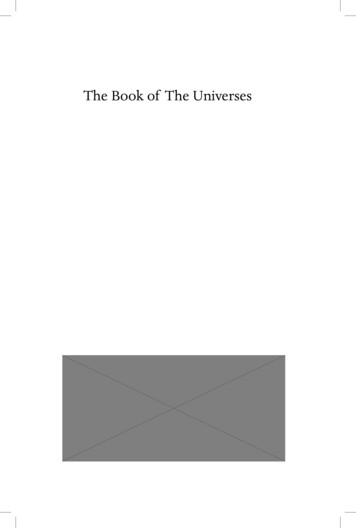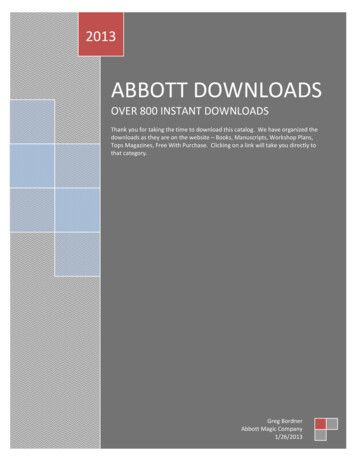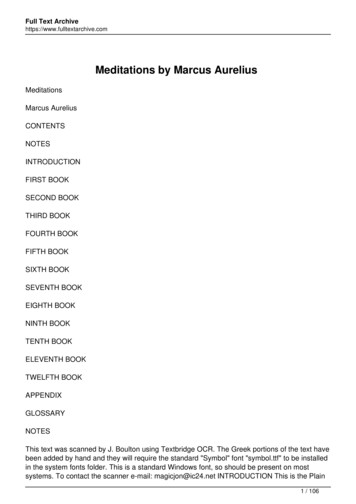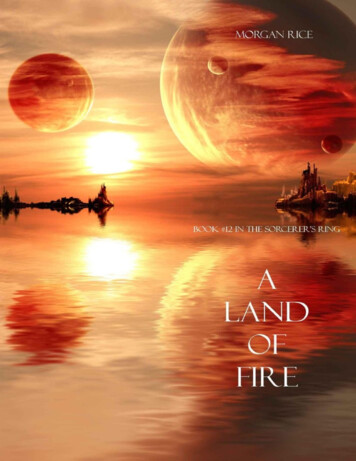
Transcription
The Book of The Universes
by the sa me authorTheories of EverythingThe Book of UniversesThe Left Hand of Creation(with Joseph Silk)L’Homme et le Cosmos(with Frank J. Tipler)The Anthropic Cosmological Principle(with Frank J. Tipler)John D. BarrowThe Anthropic Cosmological Principle(with Frank J. Tipler)The World within the WorldThe Artful UniversePi in the SkyPerché il mondo è matematico?ImpossibilityThe Origin of the UniverseBetween Inner Space and Outer SpaceThe Universe that Discovered ItselfThe Book of NothingThe Constants of Nature:From Alpha to OmegaThe Infinite Book:A Short Guide to the Boundless,Timless and EndlessNew Theories of EverythingCosmic Imagery:Key Images in the History of Science100 Essential ThingsYou Didn’t KnowYou Didn’t KnowTHE BODL EY HEADLONDON
Published by The Bodley Head 20112 4 6 8 10 9 7 5 3 1Copyright John D. Barrow 2011John D. Barrow has asserted his right under the Copyright, Designsand Patents Act 1988 to be identified as the author of this workThis book is sold subject to the condition that it shall not,by way of trade or otherwise, be lent, resold, hired out,or otherwise circulated without the publisher’s priorconsent in any form of binding or cover other than thatin which it is published and without a similar condition,including this condition, being imposedon the subsequent purchaser.First published in Great Britain in 2010 byThe Bodley HeadRandom House, 20 Vauxhall Bridge Road,London sw1v 2sawww.bodleyhead.co.ukwww.rbooks.co.ukAddresses for companies within The Random House Group Limited can be found at:www.randomhouse.co.uk/offices.htmThe Random House Group Limited Reg. No. 954009A CIP catalogue record for this bookis available from the British Libraryisbn 9781847920980The Random House Group Limited supports The Forest StewardshipCouncil (FSC), the leading international forest certification organisation.All our titles that are printed on Greenpeace approved FSC certified papercarry the FSC logo. Our paper procurement policy can be found atwww.rbooks.co.uk/environmentTypeset by Palimpsest Book Production Limited, Falkirk, StirlingshirePrinted and bound in Great Britain byClays Ltd, St Ives PLCTo TillyFor whom there are many universes to come
ContentsPreface1:00Being in the Right Place at the Right Time 00Two men walking 00Funny things, universes 00The importance of place 00Aristotle’s spherical universe 00Ptolemy’s ‘Heath Robinson’ universeCopernican revolutions 002:00The Earnestness of Being Important 00Special times and special places 00Democratic laws 00The changing Universe 00The nebular hypothesis 00Life in an Edwardian universe 00The decaying Universe 00Karl Schwarzschild: the man who knew too much 003:Einstein’s Universes00Completing a Copernican vision 00Einstein’s insight 00A digression 00The creation of Einstein’s universe of motionless matter 00The creation of a second universe: de Sitter’s universe ofmatterless motion 00
T he Book of UniversesContentsFriedmann’s universes of matter in motion 00Lemaître’s universes 00The universe of Einstein and de Sitter 00Tolman’s oscillating universe 00Lemaître and Tolman’s kinky universe 00Milne’s universe (and Newton’s universes) 004: Unexpected Universes: the Rococo Period00Fractal universes 00Dr Kasner’s universe 00Dirac’s universe – where gravity decays 00Einstein and Rosen’s undulating universe 005: Something Completely Different00A Swiss-cheese universe 00Perturbed universes 00Schrödinger’s universe 00Gödel’s spinning universe 006: The Steady Statesmen Come and Go with a Bang 00A universe that always was, is and is to come 00A table-top universe 00The electric universe 00Hot universes 007: Universes, Warts and All 00Turbulent universes 00Distorted universes: from one to nine 00Smooth universes and a new observational window 00Chaotic universes 00Mixmaster universes 00Magnetic universes 00The universes of Brans and Dicke 00Matter–antimatter universes 008: The Beginning for Beginners00Singular universes 00Which universes are singular? 00Cold and tepid universes 00An unexpectedly simpler universe 00And a unified way of thinking 009: Brave New Worlds 00Asymmetric universes 00Problem universes 00Inflationary universes 00Chaotic inflationary universes 00Eternal inflationary universes 00Suddenly, the universe seems simpler again 00The many universes run out of control 0010: Post-Modern Universes 00Random universes 00Probable universes 00Anthropic universes 00Possible universes 00Home-made universes 00Naturally selected universes 00Fake universes 00Universes where nothing is original 00Boltzmann’s universe 0011: Fringe Universes00Wrap-around universes 00Quantum universes 00A self-creating universe 00Colliding universes 00The dying of the light 00Hyperuniverses 00
12:The Runaway Universe00The best-buy universe 00The preposterous universe 00The puzzling universe 00Notes 000Index 000Preface (to come)
T he Book of UniversesPreface to followPrefacePreface to follow
T he Book of UniversesPreface to followPrefacePreface to follow
T he Book of UniversesPreface to follow1 Being in the Right Place atthe Right TimeI know it’s all in our minds, but a mind is a powerful thing.Colin Cotterill1t wo me n wal kin gI am always surprised when a young man tells me he wants towork at cosmology; I think of cosmology as something thathappens to one, not something one can choose.William H. McCrea2The old gentleman walking down the street looked the same as ever –distinguished but slightly dishevelled, in a Bohemian style, a slow-walkingEuropean on an American main street, sad-faced, purposeful but notquite watching where he was going, always catching the attention ofthe locals as he made his way politely through the shoppers and thecontra-flow of students late for lectures. Everyone seemed to know whohe was but he avoided everyone’s gaze. Today, he had a new companion,very tall and stockily built, a little the worse for wear, untidy but in adifferent way to his companion. They were both deep in conversationas they made their way, walking and talking, oblivious of the shopwindows beside them. The older man listened thoughtfully, sometimesfrowning gently; his younger companion enthusiastically pressing hispoint, occasionally gesticulating wildly, talking incessantly. Neither spokenative English but their accents were quite different, revealing resonanceswith many places. Intent on crossing the street, they stopped, lingeringat the kerbside as the traffic passed. The traffic lights changed and they
T he Book of Universescontinued quietly across the street, both momentarily concentrating onlight, sound and relative motion. Suddenly, something happened. Thetaller man started to say something again, making a dart of his hand.The traffic was moving again now but the old man had stopped, deadin his tracks, oblivious to the cars and the hurrying pedestrians. Hiscompanion’s words had consumed his thoughts entirely. The cars roaredpast on both sides leaving the two of them marooned in their midst likea human traffic island. The old man was deep in thought, the youngerone reiterating his point. Eventually, resuming contact with the movingworld around them, but forgetful of where they had been going, theolder man led them silently towards the pavement – the one they hadstepped off a minute ago – and they walked and talked their way fromwhence they had come, lost in this new thought.The two men had been talking about universes.3 The place wasPrinceton, New Jersey, and the time was during the Second WorldWar. The younger man was George Gamow, or ‘Gee-Gee’ to hisfriends, a Russian émigré to the United States. The older man wasAlbert Einstein. Einstein had spent the previous thirty years showinghow we could understand the behaviour of whole universes withsimple maths. Gamow saw that those universes must have had a pastthat was unimaginably different to the present. What had stoppedthem both in their tracks was Gamow’s suggestion that the laws ofphysics could describe something being created out of nothing. Itcould be a single star; but it might be an entire universe!f u n n y t h i n g s, u n i v er s esHistory is the sum total of the things that could have beenavoided.Konrad AdenauerWhat is the universe? Where did it come from? Where is it heading?These questions sound simple but they are amongst the most far-reachingthat have ever been posed. Depending upon how much you know, thereare many answers to the question of what we mean by ‘universe’.4 Is itjust everything you can see out in space – perhaps with the space in-between thrown in for good measure? Or is it everything that physicallyT he Book of Universes exists? When you draw up the list of all those things to include in ‘everything’ you start to wonder about those ‘things’ that the physicists callthe ‘laws of Nature’ and other intangibles like space and time. Althoughyou can’t touch or see them, you can feel their effects, they seem prettyimportant and they seem to exist – a bit like the rules of football – andwe had better throw them in as well. And what about the future andthe past? Just focusing on what exists now seems a bit exclusive. And ifwe include everything that has ever existed as part of the universe, whynot include the future as well? This seems to leave us with the definitionthat the universe is everything that has existed, does exist and will everexist.If we were feeling really pedantic we might take an even granderview of the universe, which includes not only everything that canexist but also everything that could exist – and finally, even that whichcannot exist. Some medieval philosophers5 were drawn to this sort ofcompleteness, adding everything that has existed, does exist and willnot exist to the catalogue of what was, is and will be. This approachseems bent upon creating problems in an area where there are enoughalready. Yet recently it has re-emerged in modern studies of theuniverse, albeit in a slightly different guise. Modern cosmologists arenot only interested in the structure and history of our universe butalso in the other types of universe that might have been. Our universehas many special and (to us at least) surprising properties that wewant to evaluate in order to see if they could have been otherwise.This means that we have to be able to produce examples of ‘other’universes so as to carry out comparisons.This is what modern cosmology is all about. It is not just an exercisein describing our Universe as completely and as accurately as possible.It seeks to place that description in a wider context of possibilitiesthan the actual. It asks ‘why’ our universe has some properties andnot others. Of course, we might ultimately discover that there is noother possible universe (whose structure, contents, laws, age and soforth are different in a way we can conceive of ) apart from the onewe see. For a long time, cosmologists were rather expecting – evenhoping – that would turn out to be the case. But recently the tide hasbeen flowing in the opposite direction and we seem to be faced withmany different possible universes, all consistent with Nature’s laws.And, to cap it all, these other universes may not be only possibilities:
T he Book of UniversesT he Book of Universes they may be existing in every sense that we attribute to ordinary thingslike you and me, here and now.t h e i m p o rta n c e o f plac eAnd [Jacob] dreamed, and behold a ladder set up on the earth,and the top of it reached to heaven: and behold the angels ofGod ascending and descending on it.Book of Genesis6People have been talking about the universe for thousands of years.It was their universe of course, not to be confused with ours. Formany it would have been just the land as far as they could journey.Or maybe it was the night sky of planets and stars that could be seenwith the naked eye. Most ancient cultures tried to create a picture ora story about what they saw around them, whether it be in the sky,on the ground or under the sea.7 This drawing of a bigger picturewas not originally driven by an interest in cosmology, but was simplyimportant to convince themselves, and others, that things had ameaning and they were part of that meaning. To admit that therewere parts of reality about which they had no conception or controlwould have created a dangerous uncertainty. This is why ancient mythsabout the nature of the universe always seem so complete: everythinghas a place and there is a place for everything. There are no ‘maybes’,no caveats, no uncertainties and no possibilities awaiting further investigation. They really were ‘theories of everything’, but they are notto be confused with science.Your time and place on Earth influenced the sense you would makeof the universe around you. If you lived near the Equator then theapparent motions of the stars each night were clear and simple. Theyrose, passed up and over your head throughout the night and thendescended to set on the opposite horizon. Every night was the sameand it felt as though you were at the centre of these celestial movements. But if you lived far from the Tropics the heavens looked verydifferent. Some stars rose above the horizon and set later that night,they came straight up and over your head before falling back to thehorizon. Others never rose or set and were always above the horizon.Figure 1.1 The Earth’s rotation axis, running through the North and SouthPoles, is tilted at about 23.5 degrees with respect to the vertical perpendicular to the Earth’s orbital plane.They seemed to trace out circles around a great centre in the sky, likethey were pinned to a wheel turning on its axis. It must have madeyou wonder what was special about that place around which the starsturned. Many myths and legends about the great millstone in the skywere framed by the inhabitants of northern latitudes to make somesense of that great nightly swirl of stars.The reason for this variation in the appearance of the night skyaround the world is a tilt of the axis around which the Earth rotateseach day (Figure 1.1). As the Earth orbits the Sun, the line throughthe Earth’s North and South Poles8 around which it rotates each dayis not perpendicular to the line its orbit traces. It is tilted away fromthe vertical at about 23.5 degrees. This has many remarkable consequences: it is the reason for the seasons. If there were no tilt thenthere would be no seasonal changes in climate; if the tilt were muchlarger then the seasonal variations would be far more dramatic.However, if you know nothing about the motion of the Earth aroundthe Sun, or the tilt of its axis, and merely look at the stars in the skyeach night, the tilt ensures that there will be a very different sky onview at different latitudes on Earth.If we extend the line from the South to the North Pole out intospace it points in a direction that we call the North Celestial Pole andaway from the South Celestial Pole. As the Earth rotates, at night wewill see the fixed stars apparently rotating past in the opposite direction across the sky. If they remain visible they will be completing agreat circle on the sky each time the Earth completes a daily revolu-
T he Book of UniversesFigure 1.2 The celestial sky seen by astronomers who are located at alatitude of L degrees north. Only half of the sky is visible to them at anymoment. Some stars, the north circumpolar stars, are so close to the NorthCelestial Pole that they never set below the horizon. A second group,around the South Celestial Pole, called the south circumpolar stars, arenever seen by the same astronomers because they do not rise above thehorizon.tion. However, not all of these circular paths across the sky will becompletely visible to us because part of the path will lie below ourhorizon. In Figure 1.2 we show what a sky watcher living at a latitudeof L degrees in the northern hemisphere will see on a clear night.9Our sky watcher’s horizon divides the sky in half. Only the part ofit above the horizon can be seen at any moment. Observing from alatitude of L degrees north means that the North Celestial Pole liesL degrees above the horizon and the South Celestial Pole lies L degreesbelow it. The Earth’s rotation makes the sky appear to rotate in awesterly direction around the North Celestial Pole. Stars are seen torise on the easterly horizon and then move up the sky before reachingT he Book of Universes their highest point, or ‘zenith’, after which they descend and set onthe westerly horizon.10There are two groups of stars that are not seen to follow this nightlyrise and fall in the sky. Stars inside a circle that extends L degrees fromthe North Celestial Pole complete their apparent circles in the skywithout ever disappearing below the horizon. If the sky is clear anddark they can always be seen.11 For European sky watchers today, theyinclude the stars in the Plough and Cassiopeia groups. Conversely,there is a collection of southern stars within a circular region of thesame extent around the South Celestial Pole which are never seen bythe southern-hemisphere sky watcher in our picture. They never riseabove his horizon.12 This is why the constellation of the SouthernCross can never be seen from northern Europe. Crucially, we can seethat the size of these regions of the sky that are always visible orinvisible varies with the latitude of the sky watcher. As your latitudeincreases and you move away from the Equator, so the sizes of theseregions increases as well. In Figure 1.3 we show how the sky wouldappear to sky watchers at three very different terrestrial latitudes.At the Equator, the latitude is zero and there are no regions ofever-visible or never-visible stars. An equatorial sky watcher canglimpse every bright star, although the two Celestial Poles are lost inthe haze down on the far horizons in practice. The stars rise, ascendto their highest points in the sky. As each star rises, its direction remainsrelatively constant and is an excellent navigational beacon for wayfaringon land or sea throughout the night. There is almost no sidewaysmotion on the sky and the sky seems to be very symmetrical andsimple. Our sky watcher gains the impression that he is at the centreof things, beneath a celestial canopy of overarching and predictablemotions that seem to be there for his convenience. The Universe looksas if he is central to it.At the extreme case of the North Pole, the latitude is 90 degreesand the visible stars neither rise nor set. They move in circles aroundthe sky. The Celestial North Pole is directly overhead and all the starscircle around it. It looks like the focal point of the universe and weare directly underneath it.At more temperate northerly latitudes, like that of ancientStonehenge in Britain at 51 degrees, there is an in-between situation.Stars lying within 51 degrees of the Celestial Pole will be seen to
Figure 1.3 T he Book of UniversesT he Book of UniversesaSouthCelestial PoleNorthCelestial PoleEquator (0 lat)bNorth Celestial Pole51 Stonehenge (51 N)North Celestial Polec90 North Pole (90 N)Figure 1.3 The appearance of the night sky seen from three different latitudes on Earth. It differs because of the change in position of the CelestialPole around which the stars appear to rotate: (a) at the Equator; (b) at thelatitude of Stonehenge in England; (c) at the North Pole. complete concentric circles on the sky with the Pole as their centre.Other stars will rise above the horizon, ascend to their zeniths, thendescend and set. The sky appears extremely lopsided. Different starsfollow different paths between their rising and setting. Most strikingof all, though, is the great swirl of stars in the direction of the CelestialPole, all circling it as if it is the hub of a great cosmic wheel (Figure1.4). For those sky watchers who know nothing of astronomy, or themotion of the Earth, there seems to be a special place in the sky.This is one reason why there is a geographical dimension in themyths about the sky and the nature of the Universe around us. Farfrom the Equator, in Scandinavia and Siberia, we find legends of thegreat circle in the sky: the millstone at whose centre the gods reside.The nearest star to the centre of the celestial swirl was given a specialimportance, hosting the throne of the sovereign of the universe aroundwhom all the stars were arrayed.13We will not be interested in tracing these myths and further here.We simply want to highlight how difficult it was to come up with apicture of the universe from an earthbound vantage point. There aresignificant biases that you will be unaware of when you know nothingabout the stars and the rotation and orientation of the Earth.Even when sophisticated early civilisations started making astronomical observations they still encountered the influence of ourparticular vantage point. We are confined to a small planet which,along with many other planets, orbits a star. Today we know aboutthis solar system of planets and the hundreds of distant stars whichhave been found to have other planets around them (more than 500at present). This familiarity makes it easy for us to forget how difficultit was to get away from an Earth-centred view and understand themotions of the other planets. As a very simple example of the difficulty, let’s think about our view from Earth of the motion of a planetlike Mars. We will assume that both the Earth and Mars orbit aroundthe Sun in circular orbits, and that the radius of the orbit of Mars isabout one and a half times larger that of the Earth’s orbit. Earth takesone year to complete its orbit and we shall assume that Mars takestwice as long to complete its orbit. Now work out the differencebetween the two orbits as time passes. This tells us the apparentmotion of Mars as seen from Earth. A graph of this is shown inFigure 1.5.
Figure 1.3FigureFigure1.5a 1.3 T he Book of UniversesT he Book of Universes aaSunEarthMarsSouthSouthCelestialCelestial PoleEquatorEquator (0 lat)(0 lat)4bbNorthNorth CelestialCelestial PolePole251 51 -5Figure 1.4 A long-time exposure in the direction of the North CelestialPole records the circular star trails around the Pole, which is located justabove the top of the tree in the centre.This curious heart-shaped loop with a cross-over (called a ‘limacon’)is interesting. As we go from the top right towards the left, we seethat Mars is moving away from the Earth. When it drops down tocut the horizontal axis at the point -5 the two planets are on oppositesides of the Sun and as far away from each other as possible. Thenas Mars starts to return towards the Earth something very strangehappens. Mars approaches the Earth and looks as if it is going tocollide with it. But then it reverses its direction and moves away again,to resume its long period of motion away from the Earth. This ‘retrograde’ motion of Mars can be detected with the naked eye over aperiod of several nights during a period of close approach. We seethat it arises each time the two planets are moving towards theirdistance of closest approach. If we look instead at one of the distantouter planets, like Saturn, whose orbit takes 29.5 Earth years tocomplete, there will be several occasions when the Earth–Saturn relative motion is in the vicinity of closest approach during each completeorbit of Saturn and there will be several loops in the picture of theapparent orbit.-4-3-2-1012-2Stonehenge (51 N)(51 N)StonehengeccNorthNorth CelestialCelestial PolePole -4Figure90 1.5 The apparent motion of the planet Mars observed from Earth.90 (a) The orbits of Earth and Mars, which are assumed to be circular, withthe radius of Mars’ orbit approximately 1.5 times that of Earth’s. Marstakes about two years (687 Earth days) to complete its orbit. (b) The twoyear orbit of Mars viewed from the Earth traces out this looped,heart-shaped figure, called a ‘limacon’. Mars moves away at first, reachingits maximum separation of 2.5 when the Earth and Mars are on oppositesides of the Sun. Mars then returns to its closest approach to Earth butsuddenly reverses direction and moves away. Then it changes direction onNorth PolePole(90 N)the(90 N)sky and starts to move away again. [ADD NOTE INDICATOR 14]NorthThe lesson we learn from this is that motions in the sky are verydifficult to interpret if you do not have an overall picture – or theory– of the motions. An early astronomer watching Mars over two yearswould have seen it moving away from us, then towards us, beforebeing apparently repelled and sent away again. What forces might beacting? Why does the motion change direction? These are difficult
T he Book of Universesquestions to answer if you are located on Earth, unaware that all theorbits (including your own vantage point) are revolving around theSun at different rates.Figure 1.6abNorth Celestial Pole51 a r i stot l e’s s ph e r i cal u niver s eAn expert is a person who avoids the small error as he sweeps onto the grand fallacy.Benjamin StolbergA complicated picture of these apparent celestial motions arosebecause of a philosophical view of the Universe introduced by Aristotlein about 350 bc in an attempt to simplify matters. Aristotle believedthat the world did not come into being at some time in the past; ithad always existed and it would always exist, unchanged in essencefor ever. He placed a high premium upon symmetry and believed thatthe sphere was the most perfect of all shapes. Hence, the universemust be spherical. In order to accommodate the objects seen in thesky, and their motions, Aristotle proposed a complicated onion-skinstructure containing no fewer than fifty-five nested spheres of transparent crystal, centred on the Earth, which is also assumed to bespherical in shape (an assumption that is very hard to reconcile withwhat he could see!). Each of the observed heavenly bodies was attachedto one of these crystal spheres, which rotated at different constantangular speeds. Various extra spheres existed between those carryingthe planetary motions. In this way, Aristotle could both explain observations and predict new things that might be seen. It had many featuresof a modern scientific theory – and many that are unrecognisable.The outer sphere of the stars in Aristotle’s picture was a realm wherematerial things could not exist – a spiritual realm. All the motions wesee were initiated by a Prime Mover acting at the boundary of thisrealm and causing the outer sphere to rotate. The rotation was thencommunicated inwards, sphere by sphere, until the whole cosmos wasin perfect rotational motion. By tinkering with the speeds at whichthe different spheres rotated, many of the features of the night skycould be explained.Aristotle’s philosophy was later absorbed and remoulded by medi-SCelestiaNorthCelestial PoleT he Book of Universes Equator (0 lat)Figure 1.3NorthCelestial PoleEquator (0 lat)b51 SouthCelestial PoleStonehenge (51 N)Figure 1.6 (a) A rotating sphere always occupies the same volume of spacebut other polyhedral shapes create a ‘void’ whenc they rotate. ThisAristotelian‘proofPole’ of the sphericity of the Earth is shown90 in RobertNorth CelestialRecorde’s picture taken from his book Castle of Knowledge (1556).However, a wine-glass-shaped universe rotating about its vertical axis,shown in (b), also satisfies Aristotle’s requirement that its rotation leaveand create no void region.eval Christian thinkers who identified the Prime Mover with the Godof the Old Testament and the outermost sphere with the ChristianStonehenge(51 N)The centrality of the Earth was concordant with the centralheaven.North Pole (90 N)part played by humanityin themedievalNorthCelestialPole world picture.c An important feature of the spherical shape for the Earth and allthe other90 outer spheres was the fact that when the sphere rotates itdoes not cut into empty space where there is no matter and it leavesno empty space behind (see Figure 1.6, which shows a sixteenth-centurydescription by the eminent Tudor mathematician and physician,Robert Recorde (1510–58)). A vacuum was impossible. It could no moreexist than could an infinite physical quantity.15 A stationary sphericalEarth always occupies the same portion of space as it rotates. If itwere a cube this would no longer be true.16 In fact, in Aristotle’s arguNorth Pole(90 N)mentthe sphere isn’t the only possible shape a rotating Earth couldhave if it is not to leave or enter a void region of space. A wine glasswill do just as well.17Aristotle did not think of motion as being created by forces betweenobjects in the way that we (following Newton) think of gravity. Forceswere innate properties of the objects themselves; they moved in amanner that was ‘natural’ for them. Circular motion was the mostNorth Celestial
T he Book of UniversesFigure 1.7T he Book of Universes perfect and natural movement of all.pto l em y ’s ‘h e at h robins on’ u niver s eI used to be an astronomer but I got stuck on the day shift.Brian Malow18We have already seen that in a solar system in which the Sun lies atthe centre and all the planets orbit around it at different speeds youwill see strange movements on the sky; other planets will seem tomove backwards for a short period. This is an illusion created by ourmotion relative to those planets. We are all orbiting at different angularspeeds and so we sometimes see other planets exhibit unusual countermotions on the sky. Aristotle and his followers needed to explain thoseobservations.A solution to this challenging problem was first found by ClaudiusPtolemy in about ad 130. It was the nearest thing to a ‘Theory ofEverything’ in the ancient world and it lasted for more than 1000 years.Ptolemy’s challenge was to reconcile the complicated motions of theplanets, and all their retrograde movements, with Aristotle’s rigidspecifications that the Earth was at the centre of the universe, all theother bodies moved in uniform circular orbits at di
The Book of Universes John D. Barrow THE BODLEY HEAD LONDON by the same author Theories of Everything The Left Hand of Creation (with Joseph Silk) L'Homme et le Cosmos (with Frank J. Tipler) The Anthropic Cosmological Principle (with Frank J. Tipler) The Anthropic Cosmological Principle (with Frank J. Tipler) The World within the World The .










